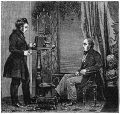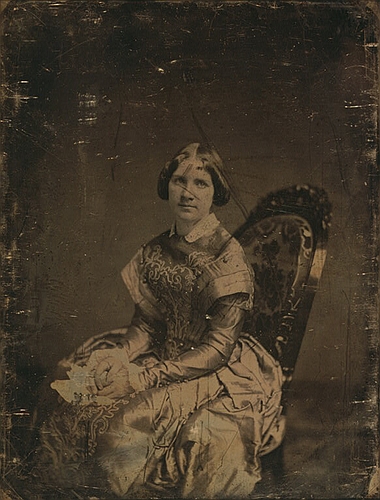| Dec 19, 2010 | Tintypes - Exterior views (1860-1900) | | | |
When one looks at salt prints and to a lesser extent Daguerreotypes of exterior views one has the sense that the photograph was taken with an artistic intent in the framing and composition that went beyond a simple documentary record. On those occasions the view might be devoid of people, human habitations or any semblance of civilization. Here we have art for art's sake.
If one looks at vast numbers of tintypes one has a different sense and surviving artistic scenic views are almost totally non-existant. This puzzled me and so I asked Andrew Daneman the possible reasons and he proposed three:
- The tintype process itself lacks tonal range and so there are no pure whites. This would render any landscapes unsatisfactory and particularly snowscapes unattractive and therefore have no artistic purpose making them unsaleable.
- Usually the creator of tintypes was an operator with limited training and lacking any formal, or informal, understanding of art. With the makers of Daguerreotypes and salt prints the best photographers were frequently educated artists and/or scientists with refined tastes, sometimes travelled widely, and had a sophisticated understanding of classical and contemporary artistic traditions.
- At the same time as tintypes were popular there was the move to a negative / positive process and the albumen print offered greater artistic control and room for experimentation. This meant that those inclined to art would not be drawn to making tintypes.
The tintype was a means of recording the everyday and as such it has immense cultural value just as would real photo postcards later. It was a means for largely itinerant photographers to earn a living and there was little or no market for low contrast photographs of a valley, an isolated tree or an untamed stream. If you can show us tintype examples of the wonders of nature we'd both be fascinated to see them and be proved wrong.
Alan Griffiths
[with thanks to Andrew Daneman]
All photographs are courtesy of the Andrew Daneman collection of American Tintypes.
Related Luminous-Lint exhibitions:

PhVTitle | Lightbox | Checklist
Exhibition: Tintypes - Exterior views (1860-1900)
| 
| | Dec 13, 2010 | Gertrude Käsebier | | | |
Examples of the work of Gertrude Käsebier.
Related Luminous-Lint exhibition:

PhVTitle | Lightbox | Checklist
Exhibition: Gertrude Käsebier
More about this photographer
| 
| | Dec 13, 2010 | Architecture: Missions Héliographiques | | | |
Works by Édouard Baldus, Henri Le Secq, Gustave Le Gray and Auguste Mestral.
As this exhibition improves travel itineraries will be added and the photographs arranged in date order. If you are a specialist in the Missions Héliographiques please get in touch - alan@luminous-lint.com
CLARIFICATION: This exhibition is of works by the photographers who participated in the Missions Héliographiques and NOT of the photographs taken specifically for the survey.
Please assist in improving this exhibition by providing scans of photographs that were definitely taken on the Missions Héliographiques along with any travel itineraries of the photographers involved. |
Related Luminous-Lint exhibitions:

PhVTitle | Lightbox | Checklist
Exhibition: Architecture: Missions Héliographiques
| 
| | Dec 13, 2010 | John Jabez Mayall - Royalty | | | |
The Photographic News, Volume IV, No.104, August 31, 1860, p.215.
Photography At The Palace.—Mr. Mayall has put together, in a "Royal Album," the series of royal photographic portraits made by him from time to time at Buckingham Palace. These exquisite studies from the real life are fourteen in number:— one of the Queen and Prince Consort, one of the Queen and Princess Beatrice, one of the Queen alone, one of the Prince alone, one of the Prince of Wales and Princess Alice, one of the Prince of Wales, one of Princess Alice, one of Prince Alfred, one of the Princesses Helena and Louisa, one of Princess Helena alone, one of Princess Louisa alone, one of Princes Arthur and Leopold, one of Prince Arthur alone, and one of Princess Beatrice; each study reproducing, with a homely truth, far more precious to the historian than any effort of a nattering court artist, the lineaments of the royal race. The Album reflects the highest credit on Mr. Mayall.—Athenaeum.
Related Luminous-Lint exhibitions:

PhVTitle | Lightbox | Checklist
Exhibition: John Jabez Mayall - Royalty
More about this photographer
| 
| | Dec 13, 2010 | Pictorialism - American Women Photographers | | | |
Examples of works by Alice Boughton, Anne Brigman, Sarah Choate Sears, Eva Watson-Schutze and Gertrude Käsebier.

PhVTitle | Lightbox | Checklist
Exhibition: Pictorialism - American Women Photographers
| 
| | Dec 12, 2010 | Richard Beard | | | |
Richard Beard (1802-1885) was the first British portrait photographer obtaining a license from Daguerre in 1841 for 150 pounds. He established his studio on the roof of the Polytechnic Institution in Regent Street, London and hired staff to take and process the portraits.
An exhibition on the work of Richard Beard and Antoine François Jean Claudet curated by Geoffrey Batchen at the Yale Center for British Art is scheduled to open in October 2011.
Related Luminous-Lint exhibitions:

PhVTitle | Lightbox | Checklist
Exhibition: Richard Beard
More about this photographer
| 
| | Dec 12, 2010 | Charles Marville | | | |
A selection of photographs showing some of the Parisian series of Charles Marville.

PhVTitle | Lightbox | Checklist
Exhibition: Charles Marville
More about this photographer
| 
| | Dec 12, 2010 | Mathew B. Brady - Brady's Daguerrean Gallery | | | |

Mathew Brady's Studio
[Jenny Lind, three-quarter length portrait of a woman, three-quarters to the left, facing front, seated]
1850, Sept
Daguerreotype, whole plate, gold toned
Library of Congress, Prints and Photographs Division
(DAG no. 509X / cph 3g06777)
Published in "Jenny Lind in New York" in The Musical World, Volume 25, No: 42, Saturday, October 19, 1850, p.671
She also objects to have her likeness exhibited; but this objection is overruled by Mr. Brady, the daguerreotypist, who shared with the sun the honour of having taken it, and on his part objects to be considered a humbug. Our meaning will be understood from the following :—
Mdlle. Jenny Lind, who, in the first place, was averse to having her likeness taken, and, in the second, did not wish to have it exhibited, has permitted Mr. Brady to show it to the public, who have importuned him for the last week, many telling him it was all humbug, and that she did not sit for her likeness at all. On Monday there was a great rush to see it, and all who had seen her pronounced it to be an admirable likeness. It is a beautiful specimen of the perfection of the photogenic art. There were eight likenesses taken in all, and every one differed from the rest, so changeable is the expression of the countenance of the great cantatrice. There were three preserved, of which Mr. Brady has two, and one is in the possession of Jenny Lind herself. The two at Mr. Brady's gallery differ very much, one of them being far superior to the other. In looking at those likenesses of Jenny Lind, we saw some exquisite portraits done on ivory, which is a new invention of. Mr. Brady, and exceedingly creditable to him.

PhVTitle | Lightbox | Checklist
Exhibition: Mathew B. Brady - Brady's Daguerrean Gallery
More about this photographer
| 
| | Dec 11, 2010 | Bisson frères - Mt. Blanc | | | |
Louis-Auguste (1814-1876) and Auguste-Rosalie (1826-1900) better known as Bisson frères had been involved in photography since the days of the Daguerreotype and were well known for their reproductions of the works of Rembrandt and Durer before they started taking architectural views of historic monuments. It is perhaps their expeditions to the Alps and Mont Blanc in the early 1860s for which they are best remembered in photo-history as early pioneers of mountain photography.

PhVTitle | Lightbox | Checklist
Exhibition: Bisson frères - Mt. Blanc
More about this photographer
| 
| | Dec 11, 2010 | Auguste Salzmann - Jerusalem | | | |
A selection of photographs by Auguste Salzmann (1824-1872) of Jerusalem. On completing his tour of Egypt and Jerusalem he returned to France with 150 calotypes and his plates were used to illustrate two volumes on Jerusalem using the Blanquart-Evrard process.

PhVTitle | Lightbox | Checklist
Exhibition: Auguste Salzmann: Jerusalem
More about this photographer
| 
|
Ongoing • Newest • Newer • Older • Oldest Mode: LL C_NEWS_CF
|

